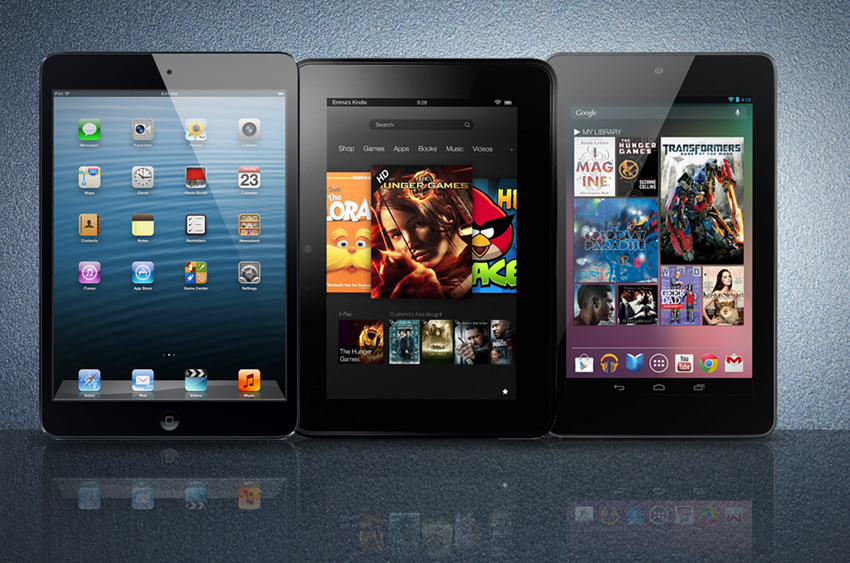 NEWS
NEWS
 NEWS
NEWS
 NEWS
NEWS
![]() Apple has just unleashed the iPad mini into the small tablet space, where it’s set to come up against some stiff competition from the likes of Google and Amazon, whose devices have already been extremely well received by punters and pundits alike.
Apple has just unleashed the iPad mini into the small tablet space, where it’s set to come up against some stiff competition from the likes of Google and Amazon, whose devices have already been extremely well received by punters and pundits alike.
The iPad mini represents quite a milestone in the history of Apple, for rarely has the Cupertino-based company been the last competitor to enter the fray. Now it’s trying to make up for lost ground with a device that looks every bit as capable as its rivals. The iPad mini’s storage options begin where most of its rivals max out, and it boasts 4G LTE connection capabilities. But – and it’s a big but – these features come at a cost. The cheapest iPad minis are selling for $330, making it by far and away the priciest seven-incher on the market. Question is, do its extra features justify the inflated price tag? Let’s find out!
Screen Size and Display
iPad mini: Retina Display with 2048×1536-pixel resolution (256ppi) with Fingerprint-resistant oleophobic coating, LED-backlit, Fingerprint-resistant oleophobic coating
Kindle Fire HD: 7” 1280×800 resolution – HD display with polarizing filter and anti-glare technology for rich color and deep contrast from any viewing angle
Nexus 7: 7” 1280×800 HD display (216 ppi), Back-lit IPS display, Scratch-resistant Corning glass
Weight
iPad mini: WiFi 308g, WiFi+cellular 312g
Kindle Fire HD: 395g
Nexus 7: 340g
Memory
iPad mini: 16, 32 and 64GB; 512MB RAM
Kindle Fire HD: 16 and 32GB; 1GB RAM
Nexus 7: 8 or 16 GB; 1GB RAM
Battery Life
iPad mini: 10 hours of surfing the web on Wi-Fi, watching video or listening to music
Kindle Fire HD: 11 hours continuous use
Nexus 7: 9 hours of HD video playback, 10 hours of web browsing, 10 hours of e-reading, 300 hours on Standby
Processor
iPad mini: 1 GHz Dual-core Apple A5 processor
Kindle Fire HD: Dual-core 1.2GHz OMAP4460
Nexus 7: Quad-core Tegra 3 processor
Wireless
iPad mini: WiFi only: Wi-Fi 802.11a/b/g/n Wi-Fi (802.11n 2.4GHz and 5GHz) and Bluetooth 4.0 technology
WiFi+Cellular: Wi-Fi (802.11a/b/g/n), Bluetooth 4.0 technology, UMTS/HSPA/HSPA+/DC-HSDPA (850, 900, 1900, 2100 MHz); GSM/EDGE (850, 900, 1800, 1900 MHz), 4G LTE (700, 2100MHz) US and Canada only, Data only, Bluetooth 4.0 technology
Kindle Fire HD: Dual-band, dual-antenna Wi-Fi (MIMO) for faster streaming and fewer dropped connections than standard Wi-Fi. Supports public and private Wi-Fi networks or hotspots that use the 802.11a, 802.11b, 802.11g, or 802.11n standard with support for WEP, WPA and WPA2 security using password authentication; does not support connecting to ad-hoc (or peer-to-peer) Wi-Fi networks
Nexus 7: WiFi 802.11 b/g/n, Bluetooth
Camera
iPad mini: 5-megapixel iSight camera, 1.2-megapixel VGA FaceTime camera
Kindle Fire HD: Front-facing HD camera
Nexus 7: 1.2MP front-facing camera
Input/Output
iPad mini: WiFi only: Lighting connector, 3.5-mm stereo headphone minijack, built-in speaker, microphone; WiFi + Cellular: Lightning connector, 3.5-mm stereo headphone minijack, built-in speaker, microphone, Nano-SIM card tray
Kindle Fire HD: USB 2.0 (micro-B connector) port for connection to a PC or Macintosh computer or to connect to the Kindle PowerFast charging accessory. Micro-HDMI (micro-D connector) port for high definition video output to televisions or A/V receivers, 3.5 mm stereo jack and integrated stereo speakers with exclusive Dolby audio engine. Stereo Bluetooth (A2DP) support for streaming audio to compatible headphones and speakers. Built-in microphone.
Nexus 7: Micro USB, Microphone, NFC (Android Beam)
Sensors
iPad mini: Three-axis gyro, Accelerometer, Ambient light sensor
Kindle Fire HD: No Information
Nexus 7: Accelerometer, Magnetometer, Gyroscope
Location
iPad mini: WiFi Wi-Fi, Digital compass; WiFi+Cellular Wi-Fi, Digital compass, Assisted GPS and GLONASS, Cellular
Kindle Fire HD: No Information
Nexus 7: GPS
Operating System
iPad mini: iOS 6
Kindle Fire HD: Customized Android 4.0.4 Ice Cream Sandwich
Nexus 7: Android 4.1 Jelly Bean
So Who’s The Winner?
At a first glance of the numbers, the iPad mini doesn’t appear to be all that it’s cracked up to be. Going against it is the fact that it has half the RAM of its rivals, less processing power, and a much, much bigger price tag than the Kindle Fire or the Nexus 7.
What the iPad mini does have going for it though is its content. Neither Amazon nor Google come close to matching the sheer number of apps that the iPad mini can pick and choose from (albeit at a cost, most of the time anyway).
Another nifty feature of the iPad mini is its new Lightning connector, just like the iPhone 5, which goes some way towards making up for its processing power deficiencies. Meanwhile, neither the Kindle Fire nor the Nexus can compete when it comes to connectivity (although Google is rumoured to have a 4G Nexus in the pipeline), and so the iPad mini wins in that category too.
Even so, the question remains, will consumers be prepared to shell out all that extra money for a device that in all honesty, isn’t that far ahead of its competitors? Apple die-hards will, but for everyone else, that remains to be seen.
Support our mission to keep content open and free by engaging with theCUBE community. Join theCUBE’s Alumni Trust Network, where technology leaders connect, share intelligence and create opportunities.
Founded by tech visionaries John Furrier and Dave Vellante, SiliconANGLE Media has built a dynamic ecosystem of industry-leading digital media brands that reach 15+ million elite tech professionals. Our new proprietary theCUBE AI Video Cloud is breaking ground in audience interaction, leveraging theCUBEai.com neural network to help technology companies make data-driven decisions and stay at the forefront of industry conversations.